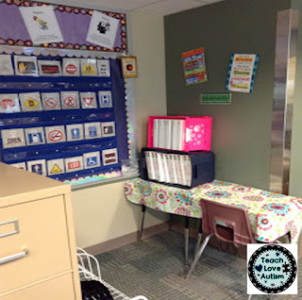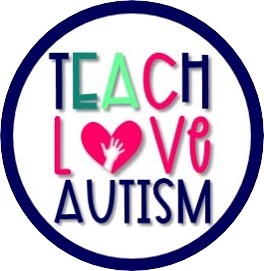Differentiating Independent Work Stations
Sharing is caring!
I dI don’t know about you all, but I love independent work! I don’t know what teacher wouldn’t. A student is completely engaged in an academic or functional task and you are able to work with others knowing that the other student is just fine and accomplishing something.
WHAT IS INDEPENDENT WORK?
In my classroom we consider independent work just that, the student can complete the task independently with no prompting (except maybe an on-task prompt here or there). So it must be a task that a student has already mastered. You cannot expect Johnny to do an independent task with clothespins and subtraction task cards if he hasn’t mastered addition yet. Or if he hasn’t mastered how to open a clothespin! You cannot expect Sarah to match colors on a file folder if she hasn’t shown that she knows that the picture of the apple you are holding up is red. Or if she can’t take the red picture off the velcro strip from the file folder.
I know I know, you are thinking… DUH!!! But in all actuality I have even caught myself making that very same mistake. You think that a student has something mastered because you have worked with them, and then you transfer that skill to be done in their independent work and they couldn’t do it as well as you thought, or you realized that there was a step that you had assisted them with when working in a direct instruction setting that now in independent work that student is unable to do and is struggling. And everyone knows that when a student cannot do the independent work that is suppose to be independent what happens?!?! BEHAVIORS!
I am definitely not trying to say as teachers we don’t know what we are doing, we are all humans we make mistakes and realize that sometimes our students may not quite have the concept the way we thought, no biggie, we just keep working on it until they do.
So in learning all this I have found that the best way to make independent work areas of my classroom work I have to differentiate everything! I know it is crazy to think of all that work that has to be done, but in my classroom it is a necessity. My students need it in order to be successful. So I wanted to share another one of the independent work stations I have in my classroom. I have three independent work areas in my room. You can read about my Work Tasks here. You can read about my Life Skills Area here.
Binderwork Independent Work Station

I know the name is super creative, but it works! So in this station I have two parts to it that makes it easy for almost any student in my classroom to complete independently so that my paras and I can work with other students. Of course we all keep our eyes scanning to be sure that no one gets off task, but for the most part my students can do this on their own.
Yes, we did go over how to do this station for about a week at the beginning of the school year to model how to work at this station. I even had paras do some of the skills in 1-1 sessions with the students to be sure they were independent with these skills before having them go to the station. This helped to ensure that the expectations weren’t set too high and it allowed for my students to find success.
So the first thing I did was collect materials that could be kept in binders for my students that varied in skill levels so that everyone could have something. What did I use?? Well here are some ideas:
-file folders that didn’t get put in a file folder and just were laminated pages that were interactive
-binder tasks made by some awesome SPED TPTers

Where did I get this stuff?? From my own store and from these other awesome TPT Sellers! I am sure there is others, but I just named a few of my all time go to ones. You can really use ANY interactive work for this!
Life Skills Independent Binders – Teach Love Autism
Independent Work Binders – Autism Adventures
Basic Skills File Folders – Simply Special Ed
Money Identification File Folders – Breezy Special Ed
Matching Real Life Vocab File Folders – Autism Classroom News

Once I had a bunch of stuff I used my color coding system to create a 1″ binder for each student in the classroom. I put their name on the spine so they can find it easily and then inside is all their personally differentiated independent work. All the work inside is things that I knew my students already knew how to do. Let’s take a look at the inside of some of their binders!

Color Coded outside of binder



Then I knew that I needed something that was fun and more open to choice for my students. Sometimes us scheduling out every part of their day gets some friends a little crazy so I decided to use Autism Adventures Monthly Independent Work Binders (link is to her blog post about her binders) to provide options for my students that finish their binder but, still have a perimeter on what they can do. I cannot take all the credit for this. She inspired creating this station by having these binders. So when they are done they are told that until our classroom timer goes off (they have 15 minutes in each work area) that they can pick from any of these monthly binders to work in.
(Picture from Autism Adventures)
This system has worked so well in my room for providing another option for independent work and filling in my students’ schedules with meaningful and engaging work. Here is a post from a fellow We Teach Sped Blogger…
How to Differentiate Your Centers Easily – The Bender Bunch
 So in order to get you started, because we all know that is the struggle, getting started. I have created a sneak peek sample of my GINORMOUS binder set that I am currently creating.This is free for you to check out all the cool types of activities I put inside my students’ binders. Click HERE for the FREEBIE!!
So in order to get you started, because we all know that is the struggle, getting started. I have created a sneak peek sample of my GINORMOUS binder set that I am currently creating.This is free for you to check out all the cool types of activities I put inside my students’ binders. Click HERE for the FREEBIE!!





3 Responses
Nice blog would like to know more.
Autism
This comment has been removed by a blog administrator.
I don't have much knowledge regarding independent work but you have provided the great detail regarding it,which I think is so beneficial for all the concerned people.